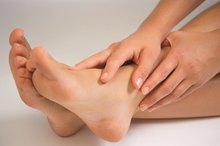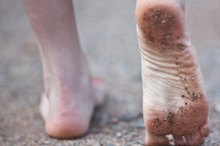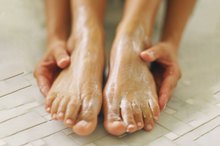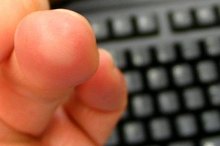Small Red Bumps on the Bottom of the Foot
Finding small red bumps on the bottom of your foot can be alarming. However, usually the cause of these bumps is a benign and treatable condition known as athlete's foot. Treatment consists of non-pharmacologic and pharmacologic measures and is relatively simple. However, you should make sure you treat your athlete's foot appropriately to decrease the chances that it will continue to recur later in life.
Causes
While the most common cause of small red bumps on the bottom of your foot is a fungal infection known as tinea pedis, or athlete's foot, according to Moise Levy and John Browning in "Long's Principles and Practice of Pediatric Infectious Disease," several other diseases may present similarly. These include contact dermatitis, atopic dermatitis--which is associated with asthma--bacterial infection and psoriasis.
About Athlete's Foot
What Is Keratin Debris?
Learn More
According to Levy and Browning, athlete's foot is most common in adolescents and adults and is most likely to occur on moist, rather than dry, feet. As detailed by Timothy Berger in "Current Medical Diagnosis and Treatment," other symptoms of athlete's foot include the formation of scaly, itchy skin on the feet, particularly in the area between the toes.
Diagnosis
Diagnosis is confirmed with a scraping taken of the potentially infected areas on your foot. The skin obtained from the scraping is put onto a microscope slide and potassium hydroxide is applied to it. Potassium hydroxide causes everything but fungi to dissolve so that if there are fungi in the sample, they are the only thing visible when the slide is examined under a microscope.
Treatment
What Does Fungus on the Bottom of Feet Look Like?
Learn More
According to Fred Ferri, in his "Ferri's Clinical Advisor," the treatment of athlete's foot is two-fold. First, you should make sure to keep your foot clean and dry, as dirty, damp feet are a fertile ground for fungal growth. Second, you should apply a topical steroid preparation to the affected areas of your foot for two to four weeks.
Prevention
Prevention is primarily effected by proper foot hygiene. Feet should be dried thoroughly each time they are wet. Socks should be changed if they become wet. Drying powders may be applied to your foot if you are unable to keep them dry with towels alone. Unfortunately, despite appropriate preventative care, most people with atheletes foot will continue to experience recurrences throughout their lives. Luckily, with proper treatment, these re-occurrences are easily managed.
- Prevention is primarily effected by proper foot hygiene.
- Drying powders may be applied to your foot if you are unable to keep them dry with towels alone.
Related Articles
References
- "Ferri's Clinical Advisor 2011"; Fred Ferri; 2010
- "Principles and Practice of Pediatric Infectious Diseases"; Sarah Long (editor); 2008
- "Current Medical Diagnosis and Treatment"; Stephen J. McPhee and Maxine A. Papadakis (editors); 2009
- Homei A, Worboys M. Fungal Disease in Britain and the United States 1850–2000: Mycoses and Modernity. Basingstoke (UK): Palgrave Macmillan; 2013. Chapter 2, Athlete’s Foot: A Disease of Fitness and Hygiene. Available from: https://www.ncbi.nlm.nih.gov/books/NBK169220/
- InformedHealth.org [Internet]. Cologne, Germany: Institute for Quality and Efficiency in Health Care (IQWiG); 2006-. Nail fungus: Overview. 2015 Jan 14 [Updated 2018 Jun 14].Available from: https://www.ncbi.nlm.nih.gov/books/NBK279547/
- InformedHealth.org [Internet]. Cologne, Germany: Institute for Quality and Efficiency in Health Care (IQWiG); 2006-. Athlete's foot: Overview. 2015 Jan 14 [Updated 2018 Jun 14].Available from: https://www.ncbi.nlm.nih.gov/books/NBK279549/
- Nigam PK, Saleh D. Tinea Pedis. [Updated 2019 Nov 25]. In: StatPearls [Internet]. Treasure Island (FL): StatPearls Publishing; 2019 Jan-. Available from: https://www.ncbi.nlm.nih.gov/books/NBK470421/
- Abd Elmegeed AS, Ouf SA, Moussa TA, Eltahlawi SM. Dermatophytes and other associated fungi in patients attending to some hospitals in Egypt. Braz J Microbiol. 2015;46(3):799–805. doi:10.1590/S1517-838246320140615
- Homei A, Worboys M. Fungal Disease in Britain and the United States 1850–2000: Mycoses and Modernity. Basingstoke (UK): Palgrave Macmillan; 2013. Chapter 2, Athlete’s Foot: A Disease of Fitness and Hygiene.
- InformedHealth.org [Internet]. Cologne, Germany: Institute for Quality and Efficiency in Health Care (IQWiG); 2006-. Nail fungus: Overview. 2015 Jan 14 [Updated 2018 Jun 14].
- InformedHealth.org [Internet]. Cologne, Germany: Institute for Quality and Efficiency in Health Care (IQWiG); 2006-. Athlete's foot: Overview. 2015 Jan 14 [Updated 2018 Jun 14].
- Nigam PK, Saleh D. Tinea Pedis. [Updated 2019 Nov 25]. In: StatPearls [Internet]. Treasure Island (FL): StatPearls Publishing; 2019 Jan-.
- Leyden JJ, Kligman AM. Interdigital athlete's foot: new concepts in pathogenesis. Postgrad Med. 1977;61(6):113-6.
- Blutfield MS, Lohre JM, Pawich DA, Vlahovic TC. The Immunologic Response to Trichophyton Rubrum in Lower Extremity Fungal Infections. J Fungi (Basel). 2015;1(2):130–137. doi:10.3390/jof1020130
- Al Hasan M, Fitzgerald SM, Saoudian M, Krishnaswamy G. Dermatology for the practicing allergist: Tinea pedis and its complications. Clin Mol Allergy. 2004;2(1):5. Published 2004 Mar 29. doi:10.1186/1476-7961-2-5
- Chollet A, Cattin V, Fratti M, Mignon B, Monod M. Which Fungus Originally was Trichophyton mentagrophytes? Historical Review and Illustration by a Clinical Case. Mycopathologia. 2015;180(1-2):1-5. doi:10.1007/s11046-015-9893-2
- Newland JG, Abdel-Rahman SM. Update on terbinafine with a focus on dermatophytoses. Clin Cosmet Investig Dermatol. 2009;2:49–63. Published 2009 Apr 21. doi:10.2147/ccid.s3690
- Hainer BL. Dermatophyte infections. Am Fam Physician. 2003;67(1):101-8.
- Jimenez-garcia L, Celis-aguilar E, Díaz-pavón G, et al. Efficacy of topical clotrimazole vs. topical tolnaftate in the treatment of otomycosis. A randomized controlled clinical trial. Braz J Otorhinolaryngol. 2019.
- Lestner J, Hope WW. Itraconazole: an update on pharmacology and clinical use for treatment of invasive and allergic fungal infections. Expert Opin Drug Metab Toxicol. 2013;9(7):911-26.
Resources
Writer Bio
Alex Folkl has been writing for more than eight years and has had work appear in several peer-reviewed and non-peer-reviewed scientific publications. He has a bachelor's degree in biology, a master's degree in pathobiology, and an MD.









